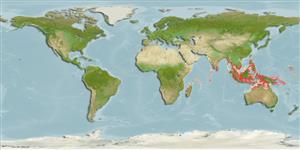Common names from other countries
Elasmobranquios (tiburones y rayas) (sharks and rays) >
Myliobatiformes (Stingrays) >
Gymnuridae (Butterfly rays)
Etymology: Gymnura: Greek, gymnos = naked + Greek, oura = tail (Ref. 45335).
More on author: Bleeker.
Environment: milieu / climate zone / depth range / distribution range
Ecología
marino asociado a arrecife; rango de profundidad 28 - 37 m (Ref. 9918). Tropical
Eastern Indian Ocean and Western Central Pacific: India to Indonesia, including Singapore and Thailand.
Length at first maturity / Tamaño / Peso / Age
Maturity: Lm 47.6, range 47 - ? cm
Max length : 106 cm WD macho / no sexado; (Ref. 58048); common length : 20.0 cm WD macho / no sexado; (Ref. 27550)
Demersal inshore, in shallow depths to at least 37 m (Ref.58048). Also found offshore (Ref. 9918). Ovoviviparous (Ref. 50449). Smallest individual was 27 cm WD. Caught often by demersal trawl, trammel and gillnet fisheries, and occasionally using tangle nets. Utilized for its meat, but of limited value due to its typically small size (Ref.58048).
Life cycle and mating behavior
Madurez | Reproducción | Puesta | Huevos | Fecundidad | Larva
Exhibit ovoviparity (aplacental viviparity), with embryos feeding initially on yolk, then receiving additional nourishment from the mother by indirect absorption of uterine fluid enriched with mucus, fat or protein through specialised structures (Ref. 50449). Distinct pairing with embrace (Ref. 205).
Compagno, L.J.V., 1999. Checklist of living elasmobranchs. p. 471-498. In W.C. Hamlett (ed.) Sharks, skates, and rays: the biology of elasmobranch fishes. Johns Hopkins University Press, Maryland. (Ref. 35766)
IUCN Red List Status (Ref. 130435)
Warning: mysqli::__construct(): (HY000/1040): Too many connections in /var/www/html/includes/func_getlabel.php on line 46
Can't connect to MySQL database (fbapp). Errorcode: Too many connections
